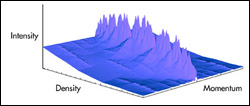’March Madness’ effects observed in ultracold gases

The image above represents the interference of wave patterns created by simulated atoms that have been "trapped" by intersecting laser beams. The complex shape of peaks and valleys is an example of a natural fractal pattern, a pattern that continues to reveal new details no matter how many times it is magnified. Credit: A.M. Rey/Harvard University
Physicists at Harvard University, George Mason University and the National Institute of Standards and Technology (NIST) have discovered new quantum effects in ultracold gases that may lead to improved understanding of electrical conductivity in metals.
In work presented at the March meeting of the American Physical Society* in Baltimore, Md., the researchers calculated the properties of an “artificial crystal” of ultracold atoms in a lattice formed by intersecting laser beams. The wave patterns in the laser light form the equivalent of row upon row of stadium seating for the atoms, an appropriate analogy given that the work was debuted during the height of college basketball’s “March Madness” tournament.
In metals like copper, two mutually exclusive types of effects tend to slow down the flow of electrons and reduce electrical conductivity, namely disorder in the crystal structure or blocking of electrons by other electrons that are already occupying a given space.
“In March Madness terms,” says NIST physicist Charles Clark, “fans who arrive early to an empty stadium can move relatively quickly down any row unless they encounter a railing, wall or other barrier (crystal disorder) but once the game begins a fan’s movements are constrained along rows by other fans already occupying seats (electron blocking).” Even though Phillip Anderson and Sir Neville Mott won the Nobel Prize in 1977 for explaining these phenomena in metals, it has been difficult to observe the effects in real materials.
By using equations dictated by the laws of quantum mechanics (the rules obeyed by nature’s smallest particles), the researchers were able to simulate gases in optical lattices as models for materials that haven’t been created yet. They found that under certain conditions electron blocking occurs even when the lattice would ordinarily be a good conductor. They also found that interference effects between the wave properties of ultracold atoms in the lattice form natural fractal patterns–that is, no matter how many times the pattern is magnified, new patterns of detail are revealed.
Media Contact
More Information:
http://www.nist.govAll latest news from the category: Physics and Astronomy
This area deals with the fundamental laws and building blocks of nature and how they interact, the properties and the behavior of matter, and research into space and time and their structures.
innovations-report provides in-depth reports and articles on subjects such as astrophysics, laser technologies, nuclear, quantum, particle and solid-state physics, nanotechnologies, planetary research and findings (Mars, Venus) and developments related to the Hubble Telescope.
Newest articles

Properties of new materials for microchips
… can now be measured well. Reseachers of Delft University of Technology demonstrated measuring performance properties of ultrathin silicon membranes. Making ever smaller and more powerful chips requires new ultrathin…

Floating solar’s potential
… to support sustainable development by addressing climate, water, and energy goals holistically. A new study published this week in Nature Energy raises the potential for floating solar photovoltaics (FPV)…

Skyrmions move at record speeds
… a step towards the computing of the future. An international research team led by scientists from the CNRS1 has discovered that the magnetic nanobubbles2 known as skyrmions can be…





















